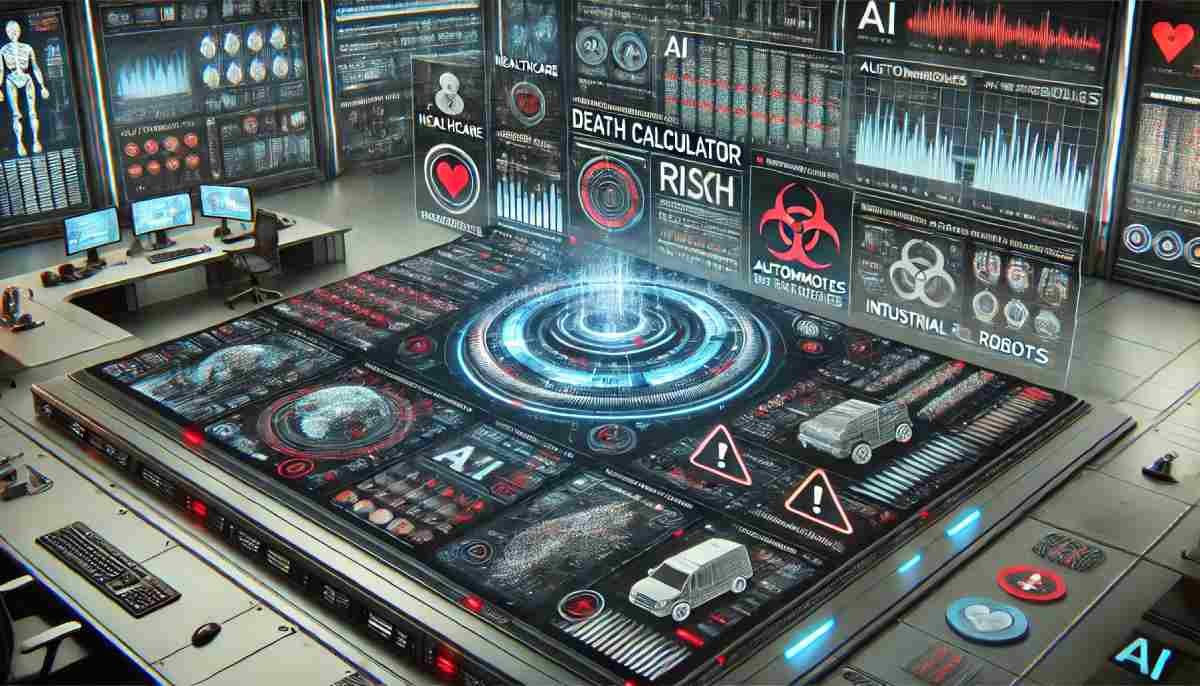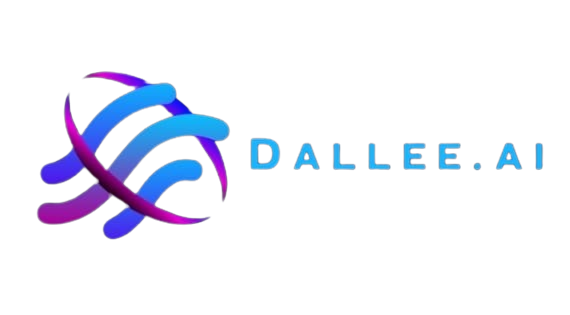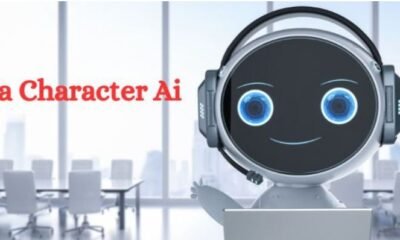Ai tools
Artificial Intelligence Death Calculator Step By Step Guideline

The idea behind an AI death calculator is to predict possible death or unfavorable consequences. It can result directly or indirectly from the growing application and development of AI tools. There are issues over the possible threats to human life caused by increasingly difficult and independent AI systems.
In order to calculate the chance of impact AI could cause in different factors. The AI Death Calculator seeks to measure and analyze these risks. The idea is based on identifying and reducing potential risks. It is related to advanced AI applications, despite the fact that it seems unreal.
Every AI technology raises different safety issues like healthcare, driverless cars, robots, military drones, and automated decision-making. Every AI technology application has different social and safety concerns. Researchers and officials want to develop protections that improve AI safety by recognizing contexts in which AI could end unexpectedly.
Society can better prepare and manage AI’s impacts, promoting responsible innovation and precaution as AI becomes more integrated into daily life. In this article, we learn about the artificial intelligence death calculator.
Key Factors Considered in Artificial Intelligence Death Calculator
A number of important parameters are considered in order to offer a careful risk assessment when it predicts death rate concerns related to AI. These factors are essential in developing accurate predictions and creating measures. Factors are included:
1: Legal Decision Making
The ethical frameworks are built into AI systems like operating healthcare services or driverless cars. It has a significant impact on how these systems prefer tasks and respond to life-and-death issues. Insufficient or inaccurate legal code presents the possibility of deadly consequences.
2: Self-Defense and Military
A further layer of risk is introduced by the use of AI in military applications, such as automated weapon systems. Concerns over accidental deaths or escalations that result in greater injury are raised by the unpredictable nature of AI-driven actions in high-stakes situations.
3: Economic Impact
A large number of people’s jobs are lost due to AI’s role in industry transformation. That is an indirect effect on public health and safety. Over time, health-related deaths are increasing due to economic instability and high stress levels. Limited access to resources is the result of automated processes.
4: Data Security and Privacy
AI systems are significant in data security and privacy. Particularly in the fields of healthcare, banking, and public buildings, they are in danger zones. People can be in danger of death when systems are unable to provide necessary services or when data is misused.
5: Ability to Make Decisions
The type of control AI systems are going over. Important choices grow as they become more independent. This independence results in situations where AI takes decisions without human input that affect people’s lives. And it raises questions about accountability and safety.
6: Unexpected Errors
AI system errors, problems, or unexpected interactions is resulting unwanted negative consequences. To understand how AI could result in accidental deaths, it is essential to know the probability and consequences of these mistakes.
Understanding the Risks of Advanced AI Systems
Advanced AI systems hold vast potential to improve lives, but they also present unique risks due to their complexity, automation, and often unpredictable behavior.
1: Loss of Human Control
Highly automated AI systems need minimal human intervention. It is difficult to predict or control their actions, especially in unforeseen circumstances. This loss of control is concerning in areas where AI decisions directly impact human safety, such as in automated vehicles or robotic surgeries.
2: System Failures and Consequences
Unexpected interactions between AI components or technical issues are producing fatal outcomes, particularly in high applications. For instance, AI in a medical device or automated drones could result in serious harm or loss of life.
3: Ethical and Moral Challenges
AI faces moral challenges when it is deciding on conflict standards of conduct. As it performs increasingly complicated roles. AI systems can create ethically questioned or negative actions. If they are not clearly programmed to manage these issues, especially in emergency situations.
4: Discrimination
Unfair data may be used to train AI systems, which might increase or even worse social injustices. Discrimination in AI systems may result in unfair treatment in criminal justice, financing, and employment, which may have an indirect effect on people’s lives and mental health.
5: Failures in Critical Infrastructure
Public safety depends on critical AI systems that control transportation networks, water supplies, and electricity grids. Widespread instability as well as harmful outcomes, including blackouts, polluted water, or accidents, result from a cyberattack or breakdown in these systems.
6: Industrial Automation Errors
In industries and offices, robots and AI devices have become more common. Accidents result from mistakes or unexpected behaviors in automated systems. Especially if a machine fails in risky activities or if suitable security protocols are not followed.
7: Inaccurate Emergency Response
Inaccurate recommendations may be made by AI systems that support emergency response. Because of poor data analysis or computational mistakes. For example, an AI may delay vital relief and put lives in danger if it ignores the impact of a natural disaster response.
8:Medical Misdiagnoses
AI is being utilized more and more in treatment planning and medical diagnostics. Due to faulty methods, incorrect data, or a lack of settings, an AI system can wrongly identify. In this condition, it can suggest an improper course of therapy, which can give deadly results.
Guidelines and Leadership in AI Safety
As AI technology is becoming powerful and embedded in critical aspects of society. The role of governance and regulations in ensuring AI safety is more important than ever. Effective governance frameworks and regulations are essential for managing.
In sum, governance and regulations play a vital role in promoting safe AI development by setting clear standards, enhancing accountability, and protecting public welfare. Here are some governance and regulations that contribute to AI safety:
- Establishing safety standards
- Ensuring accountability and transparency
- Mitigating bias and protecting human rights
- Military and autonomous weapon systems
- Implementing certification and testing requirements
- Promoting ethical AI research and development
- Creating mechanisms for public input and oversight
- Supporting adaptable and international collaboration
- Developing consequence management frameworks
The Future Outlook
The future of AI promises significant advances in a variety of sectors, but it also raises questions about human safety and moral consequences. Achieving a balance between maximizing AI’s promise and avoiding its risks is critical for a safe and successful future.
1: AI will be focused and centered on human values and ensure that AI decision-making respects human rights and social rights.
2: In-vehicle and medical diagnosis standards will require authentic testing, validation, and certification processes to verify.
3: The future is looking for stronger regulations and advanced cybersecurity measures. Specially to ensure the critical infrastructures remain secure.
4: Robotic “kill switch” approach, built a critical system. This system acts unpredictably or dangerously without human control.
5: AI systems should be designed to work and collaborate with humans and enhance their capabilities rather than replace them.
Conclusion
To summarize, in this article, we look at how the artificial intelligence death calculators have affected all eras of human lives. It is most likely influenced by a mix of ethical development techniques, strong regulatory frameworks, and increased involvement by stakeholders.
All features of this tool seek to maximize the benefits of AI while reducing its risks. As a result, it is a balanced approach to technological growth that emphasizes human security and health. AI systems can operate safely and reliably in real-world environments.
Follow Dallee for more AI updates and News.

-

 AI Chatbot1 year ago
AI Chatbot1 year agoJoyland AI: An In-Depth Guide to AI Storytelling and Character Creation
-

 Artificial Intelligence1 year ago
Artificial Intelligence1 year agoIs Janitor AI down? Analyzing Janitor AI’s Current Status:
-

 Artificial intelligence1 year ago
Artificial intelligence1 year agoWhat is Chain-of-Thought (CoT) Prompting: A Beginner’s Guide
-

 Ai News1 year ago
Ai News1 year agoChat GPT Login: Easy Step-By-Step Access Guide
-

 Artificial intelligence1 year ago
Artificial intelligence1 year agoBeta Character AI: Everything You Need To Know
-

 Ai News1 year ago
Ai News1 year agoGPT-5: Features, Abilities And Everything You Should Know About GPT-5
-

 Art generator1 year ago
Art generator1 year agoTop 8 Free NSFW AI ART Generators From Text Prompts
-

 Ai Tool1 year ago
Ai Tool1 year agoHow To Make Download Video From Y2mate com 2024



